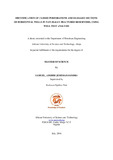| dc.description.abstract | The use of horizontal wells with zonal isolations is a common completion practice in the oil and gas industry to check for very significant production challenges such as wellbore damage/skin, early water breakthrough and gas coning, rapid pressure depletion, dampened recovery efficiency and overall well productivity. Notwithstanding, the use of zonal isolators invariably alters the transient pressure response of horizontal wells. In this research, the use of well test analysis has been extended to studying the effect of this completion technique on the pressure response and flow regimes of horizontal wells in naturally fractured formations. It further evaluates the performance of the zonal isolations in this formation and proposes a means of identifying and determining the locations of malfunctioning isolations. This was achieved by developing analytical models that simulate the pressure responses and flow regimes in the vicinity of the wellbore, and the outer boundaries of the formations. These models have been derived based on the assumption that the reservoir can be divided into multiple producing and non-producing intervals. Ozkan’s Laplace transformation approach to developing solutions to the transient flow problem in porous media served as the main basis for developing the pressure response models, as it presents a less complicated approach to incorporating the influence of natural fractures, wellbore storage, and skin.
The main finding of this study is that the dominant effect of zonal isolators in naturally fractured formations can be noticed during the early time flow regimes of the well, which is the early linear regime. The late time flow regime, pseudo-radial, is not affected by the presence of isolators. In addition, it was found that the number of zonal isolations and the length of the well were the factors that most influenced the well’s pressure response. The effects of the number and length of isolators for different well lengths have been investigated and a set of type-curves of dimensionless pressure and pressure derivative versus dimensionless time have been generated to characterize the formations. These plots can be used to verify the number and length of zonal isolations originally installed, as well as to determine the number and locations of malfunctioning isolators.
Tiab’s Direct Synthesis (TDS) technique has also been applied using the plots of the pressure and pressure derivative curves, to enable the identification of some features of the well’s pressure behavior, including the point of intersection of straight lines for the early and late time flow regimes. This is useful to verify the results and its usefulness has been demonstrated in this study. | en_US |

